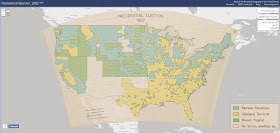The Atlas of Historical Geography of
the United States was written by Charles Paullin, a historian for the US Navy, between 1912 and
1932 and is considered a classic of the genre. The University of Richmond (yes,
Richmond Virginia) has put it online for your enjoyment.
Presidential Election of 1892
You think you know American history? You think you know where this country came from and how it has acted in the past? Ha, I say. Although this atlas will not reveal all the dirt, not by any means, many of the complications and contradictions that make America the great, misunderstood, and completely weird place that it is are present in this atlas, if sometimes between the lines.
There are several areas that are particularly valid for this self-study of your own nation, but lets examine two of them: the section on political elections showing who voted for whom in a presidential election, and the section on the American territories as it evolved.
These maps must be read with a nuanced eye. Recall that we are a representative democracy, so they say, which means that we elect people to represent us in Washington indirectly, we do not elect the President directly, for example. Although somewhat true this picture has changed over time and you may wish to review the rules by which the Senate and the POTUS (president of the United States, as it is abbreviated in certain circles) are elected.
http://en.wikipedia.org/wiki/United_States_presidential_election
http://en.wikipedia.org/wiki/United_States_Senate
Now, my fellow citizens, go to the Atlas and review the various presidential elections and who voted for whom. Consider as you do so some of the following: the history of the so-called Blue and Red states, who or what was the Anti-Masonic party, why were there two Democratic candidates in 1860 who split the vote and elected that Republican Abraham Lincoln (yes, the man who "freed the slaves" quote end quote was a Republican, kindof hard to believe, isn't it), what was the Progressive Party and why was Roosevelt running under that Party label?
Notice how many elections the name "Roosevelt" appears. So far as I know there were only two Roosevelt's in the history of the Presidency, yet between the two of them, Theodore and FDR, we get quite a few elections. Bully ! Maybe what we need today is a third Roosevelt?
For your information, the "Anti Masonic" Party was our first third party in America and was devoted to exposing and removing the secret influence of "Freemasonry" on our government. Ha. Obviously, they failed.
http://en.wikipedia.org/wiki/Anti-Masonic_Party
On a more practical level, and for those who are interested in military history, the Atlas has such gems as the state of the transportation and postal routes right before the War of the American Revolution. Its remarkably sparse, basically a single route from north to south.
Probably the subject with the most potential for nuance (e.g. hidden crimes) involves the territorial expansion of the United States and the issues of the Native Americans. Or is it the issue of our relations with Mexico? There are so many to choose from, I don't where to begin.
There are several areas that are particularly valid for this self-study of your own nation, but lets examine two of them: the section on political elections showing who voted for whom in a presidential election, and the section on the American territories as it evolved.
These maps must be read with a nuanced eye. Recall that we are a representative democracy, so they say, which means that we elect people to represent us in Washington indirectly, we do not elect the President directly, for example. Although somewhat true this picture has changed over time and you may wish to review the rules by which the Senate and the POTUS (president of the United States, as it is abbreviated in certain circles) are elected.
http://en.wikipedia.org/wiki/United_States_presidential_election
http://en.wikipedia.org/wiki/United_States_Senate
Now, my fellow citizens, go to the Atlas and review the various presidential elections and who voted for whom. Consider as you do so some of the following: the history of the so-called Blue and Red states, who or what was the Anti-Masonic party, why were there two Democratic candidates in 1860 who split the vote and elected that Republican Abraham Lincoln (yes, the man who "freed the slaves" quote end quote was a Republican, kindof hard to believe, isn't it), what was the Progressive Party and why was Roosevelt running under that Party label?
Notice how many elections the name "Roosevelt" appears. So far as I know there were only two Roosevelt's in the history of the Presidency, yet between the two of them, Theodore and FDR, we get quite a few elections. Bully ! Maybe what we need today is a third Roosevelt?
For your information, the "Anti Masonic" Party was our first third party in America and was devoted to exposing and removing the secret influence of "Freemasonry" on our government. Ha. Obviously, they failed.
http://en.wikipedia.org/wiki/Anti-Masonic_Party
On a more practical level, and for those who are interested in military history, the Atlas has such gems as the state of the transportation and postal routes right before the War of the American Revolution. Its remarkably sparse, basically a single route from north to south.
Probably the subject with the most potential for nuance (e.g. hidden crimes) involves the territorial expansion of the United States and the issues of the Native Americans. Or is it the issue of our relations with Mexico? There are so many to choose from, I don't where to begin.
So be sure to check out this website and keep your favorite search engine handy for research. Its for your own good. Trust me.
States, Territories and Cities, long ago
The University of Richmond
The Digital Scholarship Lab at the
University of Richmond


No comments:
Post a Comment